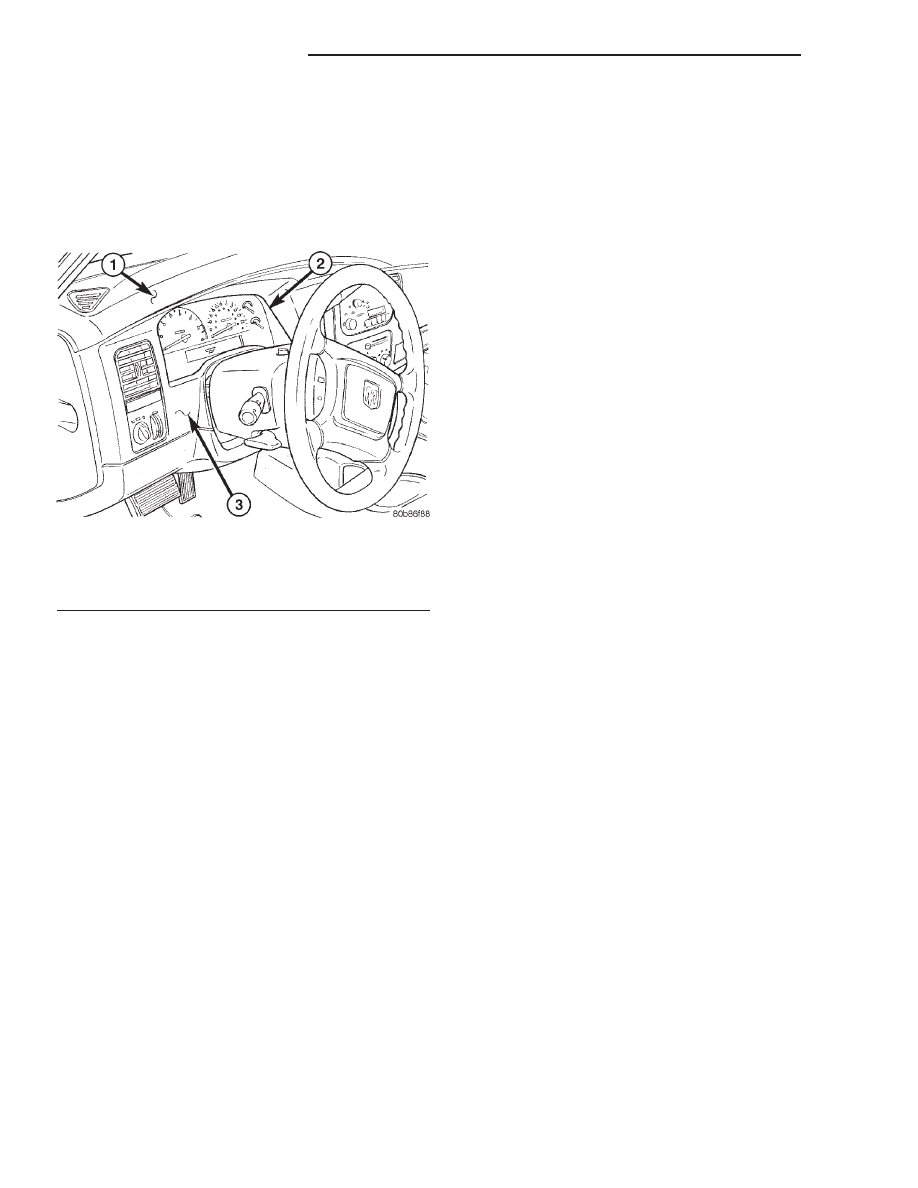Dodge Dakota (R1). Manual - part 319

WASHER FLUID INDICATOR
WASHER FLUID INDICATOR . . . . . . . . . . . . . . 36
WATER-IN-FUEL INDICATOR
INSTRUMENT CLUSTER
DESCRIPTION
The instrument cluster for this model is an Elec-
troMechanical Instrument Cluster (EMIC) module
that is located in the instrument panel above the
steering column opening, directly in front of the
driver (Fig. 1). The EMIC gauges and indicators are
protected by an integral clear plastic cluster lens,
and are visible through a dedicated opening in the
cluster bezel on the instrument panel. Just behind
the cluster lens is the cluster hood and integral clus-
ter mask, which are constructed of molded black
plastic. The cluster hood serves as a visor and shields
the face of the cluster from ambient light and reflec-
tions to reduce glare, while the cluster mask serves
to separate the define the individual gauges and the
information center area of the EMIC. Behind the
cluster hood and mask is the cluster overlay and
gauges. The overlay is a laminated plastic unit. The
dark, visible surface of the outer layer of the overlay
is marked with all of the gauge identification and
graduations, but this layer is also translucent. The
darkness of this outer layer prevents the cluster from
appearing cluttered or busy by concealing the cluster
indicators that are not illuminated, while the trans-
lucence of this layer allows those indicators and icons
that are illuminated to be readily visible. The under-
lying layer of the overlay is opaque and allows light
from the various indicators and illumination lamps
behind it to be visible through the outer layer of the
overlay only through predetermined cutouts. On the
lower edge of the cluster lens just left of center, the
odometer/trip
odometer
switch
knob
protrudes
through dedicated holes in the cluster mask and the
cluster lens. The remainder of the EMIC, including
the mounts and the electrical connections, are con-
cealed behind the cluster bezel. The molded plastic
EMIC housing has four integral mounting tabs, two
each on the upper and lower edges of the housing.
The EMIC is secured to the molded plastic instru-
ment panel cluster carrier with four screws. All elec-
trical connections to the EMIC are made at the back
of the cluster housing through two take outs of the
instrument panel wire harness, each equipped with a
self-docking connector.
A single EMIC module is offered on this model;
however, some variations of this module exist due to
optional equipment and regulatory requirements.
This module utilizes integrated circuitry and infor-
mation carried on the Programmable Communica-
tions Interface (PCI) data bus network for control of
all gauges and many of the indicators. (Refer to 8 -
ELECTRICAL/ELECTRONIC
CONTROL
MOD-
ULES/COMMUNICATION - DESCRIPTION). The
EMIC also uses several hard wired inputs in order to
perform its many functions. In addition to instru-
mentation and indicators, the EMIC has hardware
and/or software to support the following functions:
• Chime Warning Requests - The EMIC sends
chime tone requests over the PCI data bus network
to the Central Timer Module (CTM) when it monitors
certain conditions or inputs. The CTM replaces the
chime or buzzer module and performs the functions
necessary to provide audible alerts that are synchro-
nized with the visual alerts provided by the EMIC.
(Refer
to
8
-
ELECTRICAL/CHIME/BUZZER
-
DESCRIPTION).
• Vacuum Fluorescent Display (VFD) Dim-
ming Service - The EMIC performs the functions
necessary to eliminate the need for a separate VFD
dimming module by providing control and synchroni-
zation of the illumination intensity of all vacuum flu-
orescent displays in the vehicle, as well as a parade
mode.
The EMIC module incorporates a blue-green digital
VFD for displaying odometer and trip odometer infor-
mation, as well as the amber cruise indicator display
function. Some variations of the EMIC are necessary
to
support
optional
equipment
and
regulatory
requirements. The EMIC includes the following ana-
log gauges:
Fig. 1 Instrument Cluster
1 - INSTRUMENT PANEL TOP COVER
2 - INSTRUMENT CLUSTER
3 - CLUSTER BEZEL
8J - 2
INSTRUMENT CLUSTER
AN